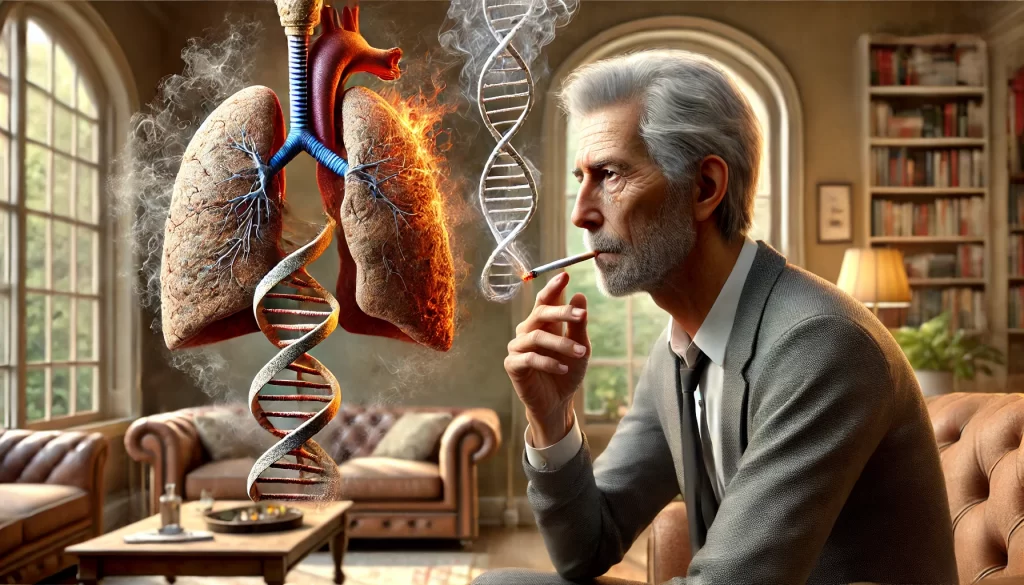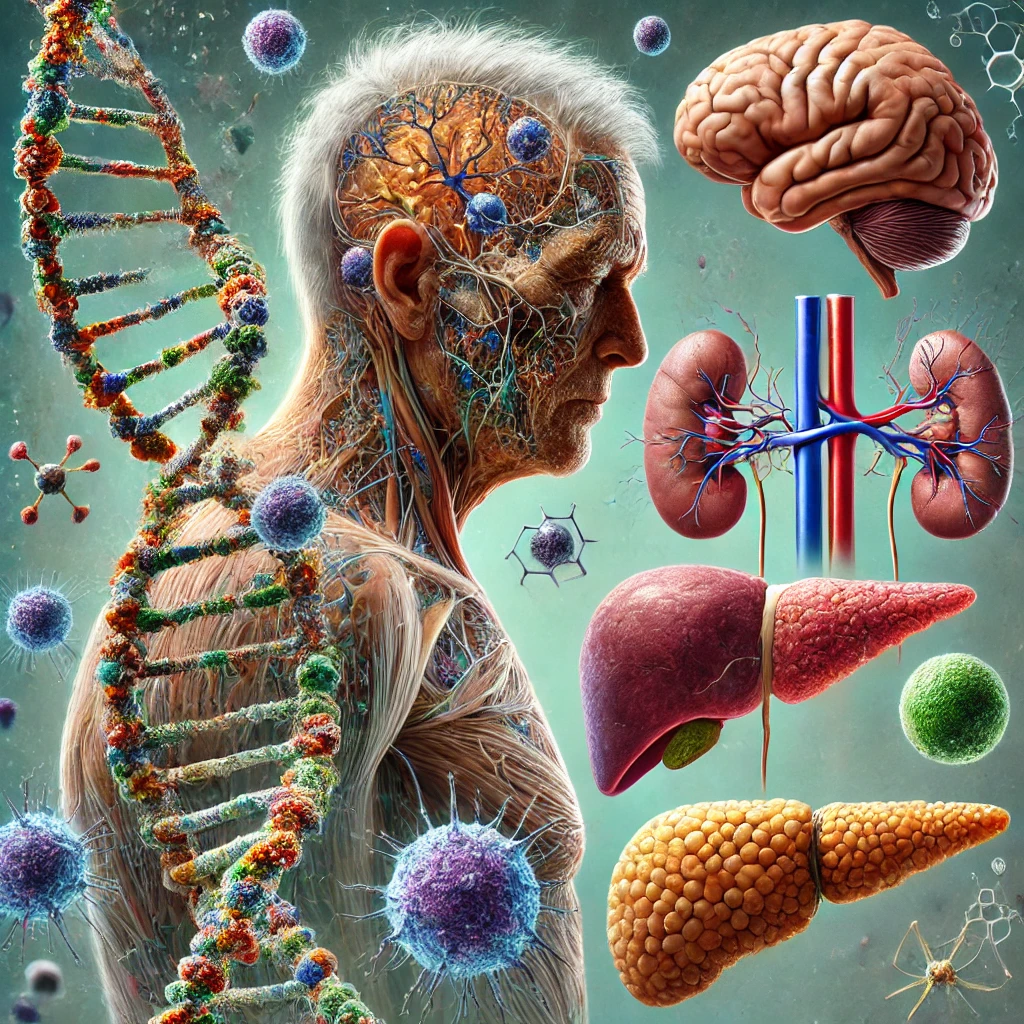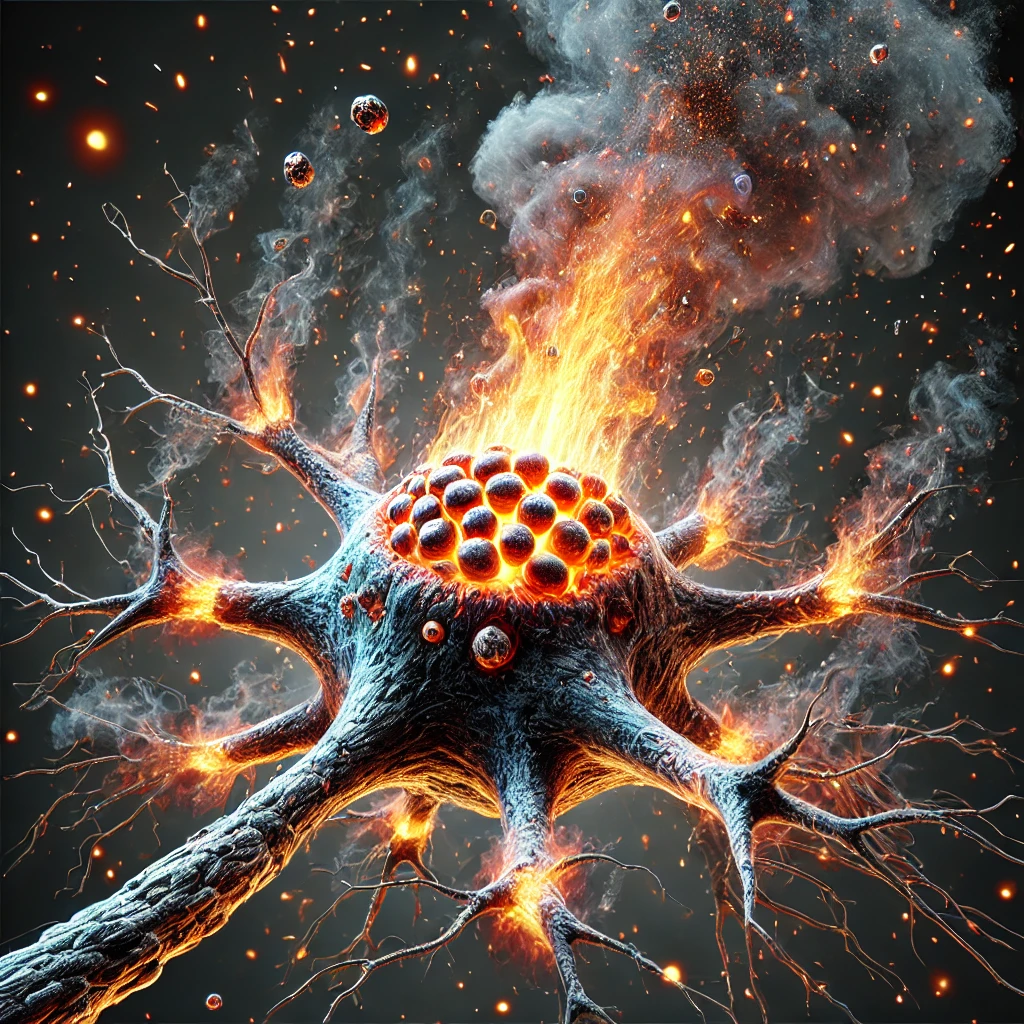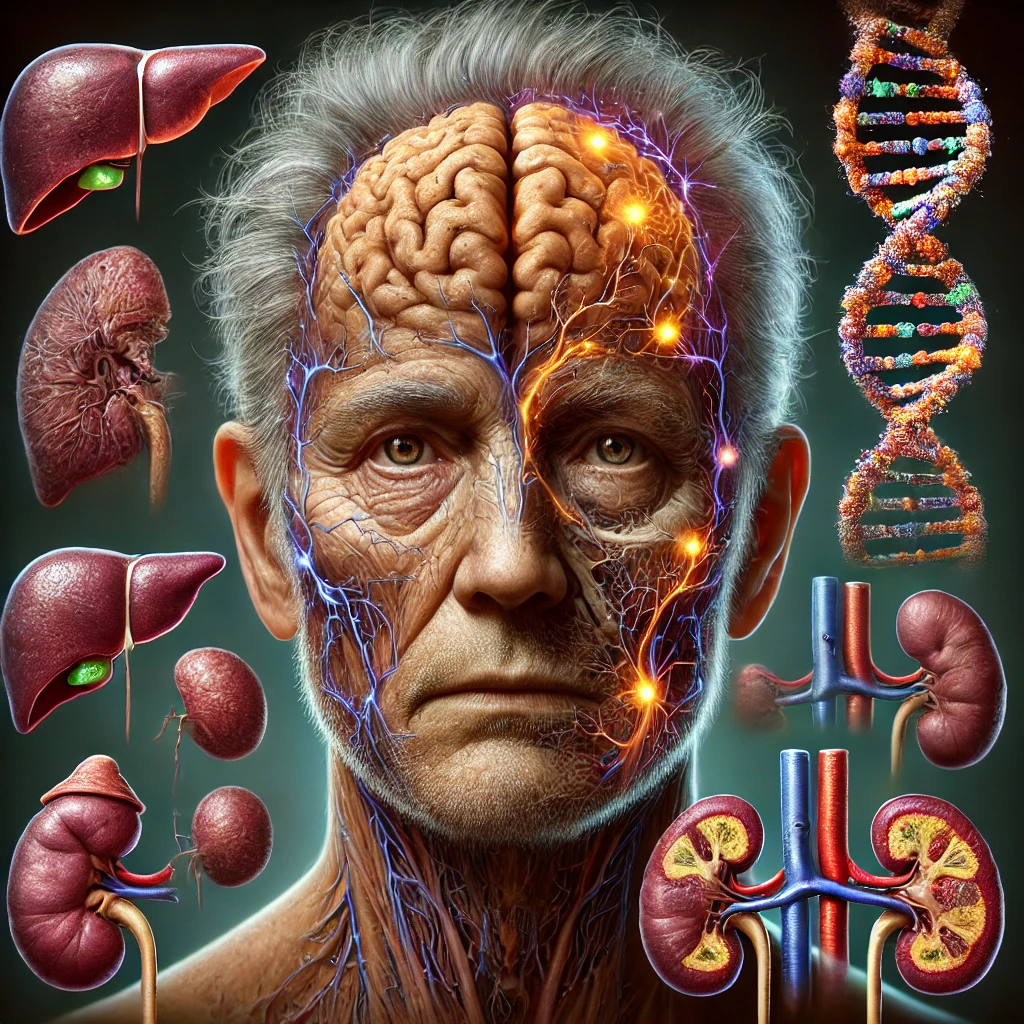El poder de sanar, en la palma de tu mano
La vida moderna está llena de desafíos, desde la contaminación ambiental hasta el ritmo frenético del día a día, que van desgastando lentamente nuestro cuerpo sin que casi lo notemos. Aunque en la mayoría de los casos nuestro organismo puede repararse y contrarrestar estos daños, llega un punto en el que esta capacidad se ve sobrepasada, dando lugar a lo que conocemos como “estrés oxidativo”(1,2,3)
¿Qué es el estrés oxidativo?
Antes de empezar a hablar de estrés oxidativo hay que hablar de los radicales libres.Los radicales libres son moléculas inestables que se forman de manera natural en nuestro cuerpo y se caracterizan por poseer uno o más electrones sin aparear (emparejar en simple). Esta inestabilidad los lleva a reaccionar rápidamente con otras moléculas, lo que puede generar daños en células, proteínas y hasta en el ADN.(4,5,6).
Sin embargo, a pesar de la aparente mala fama que suele recibir, el estrés oxidativo no solo no es dañino, si no que esencial para la vida. En niveles adecuados, forma parte de procesos vitales que ayudan a nuestro cuerpo a adaptarse y a defenderse de amenazas externas o situaciones de estrés como el ejercicio físico (7,8,9). El problema aparece cuando el equilibrio se rompe y la generación de radicales libres excede la capacidad de nuestro cuerpo para combatirlos. Allí es cuando el estrés oxidativo se convierte en un riesgo real para nuestra salud, y entender cómo manejarlo puede hacer la diferencia entre un cuerpo sobrecargado y uno capaz de restaurar su balance natural.(10,11,12,13,14)
¿Cómo se producen los radicales libres?
- Factores internos: Al convertir los alimentos en energía en la mitocondria, nuestras células liberan pequeñas cantidades de radicales libres. (4,9,15)
- Factores externos: Elementos como la contaminación, la radiación, el tabaco y ciertos químicos pueden aumentar la producción de radicales libres.(6,13,15)
¿Cómo se eliminan?
1)Sistemas antioxidantes endógenos: Nuestro cuerpo cuenta con la capacidad de generar antioxidantes propios (como el glutatión) que neutralizan los radicales libres inestables.(4,8,9)
2)Antioxidantes de la dieta o suplementos: Nutrientes como las vitaminas C y E, los antioxidantes presentes en frutas y verduras también ayudan a reducir el impacto de los radicales libres. (16,17)
Causas del estrés oxidativo
Varias factores pueden contribuir al estrés oxidativo:
- Dieta inadecuada: Un consumo elevado de alimentos ultraprocesados, azúcar y grasas industriales aumenta la producción de radicales libres (15,16,18,25)
- Contaminantes ambientales: La exposición a la contaminación (aire contaminado por tabaco (fumador pasivo), autos, minería), pesticidas o radiación generan radicales libres en el cuerpo de formas muy pronunciadas
- Tabaquismo y consumo de alcohol: Ambos hábitos incrementan la cantidad de radicales libres en el cuerpo (6,13,19,20)
- Inflamación crónica de bajo grado: La inflamación prolongada puede conducir a un aumento del estrés oxidativo (10,12). Hice un post sobre esto por si lo quieres leer, es un gran complemento (21)
- Sedentarismo o exceso de ejercicio: La falta de actividad física o el sobre entrenamiento pueden desequilibrar la producción de radicales libres y antioxidantes (22). El ejercicio moderado genera radicales libres pero a su vez se generan antioxidantes que los neutralizan. De ahí que el ejercicio es un gran aliado en la adaptación del estrés y ese equilibrio entre radicales libres y antioxidantes es el que permite que se generen las adaptaciones que mejoran el rendimiento en el ejercicio. (8,9,23)
- Estrés psicológico: El estrés psicológico crónico puede elevar los niveles de estrés oxidativo (2,3,15)
- Privación de sueño: Un sueño insuficiente afecta la capacidad del cuerpo para combatir el estrés oxidativo (1,40)
- Daño mitocondrial: Las mitocondrias generan energía para nosotros y en el proceso se crean radicales libres que, al exceder nuestra capacidad antioxidante, dañan su ADN y reducen la producción de ATP, desencadenando un círculo vicioso de estrés oxidativo que acelera el envejecimiento y favorece la aparición de distintas enfermedades .(11,24,26,27)

Consecuencias del estrés oxidativo
El estrés oxidativo se ha asociado con múltiples problemas de salud:
- Envejecimiento acelerado: Aceleración del envejecimiento de la piel y los órganos (5,12,28,29,30)
- Enfermedades cardiovasculares: Daño a los vasos sanguíneos que conduce a condiciones cardíacas (27,31,32,33)
- Enfermedades neurodegenerativas: Enfermedades como Alzheimer y Parkinson (11,33).
- Cáncer: El daño al ADN puede provocar mutaciones y desarrollo de cáncer (10,34,35,36).
- Diabetes y síndrome metabólico: El estrés oxidativo juega un papel en la resistencia a la insulina (31,33,37).
- Enfermedades oculares (el ojo): Condiciones como cataratas y degeneración macular (38).


Exagerando un poco pero se podría que el estrés oxidativo descontrolado le hace esto a tus neuronas
Medidas de acción para reducir el estrés oxidativo
Adoptar ciertos cambios en el estilo de vida puede ayudar a disminuir el estrés oxidativo:
- Dieta equilibrada: Consumir alimentos naturalmente ricos en antioxidantes como frutas, verduras, nueces y granos integrales (16).
- Ejercicio moderado y regular: Participar en actividad física moderada para mejorar las defensas antioxidantes (8,9,23).
- Evitar agentes tóxicos:: Limitar la exposición a contaminantes, evitar el tabaco y reducir la ingesta de alcohol (6,13,) así como la exposición a contaminantes en el aire. Si te lo puedes permitir comprar un filtro de aire es buena opción (39)
- Manejo del estrés: Practicar técnicas de relajación como meditación y respiración profunda no reducirá el estrés oxidativo per se, pero te ayudará a reducir el estrés mental que si se asocia a estrés oxidativo (2)
- Sueño adecuado: Asegurar entre 7-9 horas de sueño de calidad por noche (1,40)
- Hidratación: La hidratación adecuada ayuda a eliminar los desechos generados por el cuerpo. La hidratación no reduce el estrés oxidativo por sí misma, sino que es más bien un medio para un fin. (41)
- Ayunos moderados: El ayuno intermitente con un rango moderado de horas puede reducir el estrés oxidativo (42)
Uso de antioxidantes: ¿Son realmente necesarios?
Aunque los antioxidantes son esenciales para mantener el equilibrio oxidativo del organismo, la gran mayoría de las veces estos no serán necesarios o si se usan serán unos cuantos y en situaciones específicas.,
- Fuentes naturales como prioridad
- Efecto adversos por abuso de antioxidantes
- Abusar de suplementos antioxidantes podría interferir con procesos de adaptación natural del cuerpo, como la respuesta inflamatoria moderada que se produce tras el ejercicio.
- Sin embargo no se han visto mayores efectos con suplementos en general
- En dosis muy altas, algunos antioxidantes podrían incluso generar un efecto pro oxidante (17,48)
En resumen, los antioxidantes son vitales para protegerse del estrés oxidativo, siendo relevante la obtención de la mayor parte de ellos a través de una dieta rica en frutas y verduras y promover la generación de antioxidantes propios (4,47).
Sugerencias finales
La clave está en comprender que el estrés oxidativo no siempre es negativo, pero su exceso puede resultar dañino. Prioriza una dieta rica en antioxidantes, ejercicio moderado, buen descanso y un manejo adecuado del estrés; considera suplementos solo en casos puntuales. Pequeños cambios constantes generan un gran impacto a largo plazo y te ayudan a mantener tu salud y bienestar en buenas condiciones.
Sigueme en instagram!! https://www.instagram.com/p/DE4-vQnR76c/?igsh=MW80OXZoeTQ2MmtoMQ==
Referencias
- Villafuerte G, Miguel-Puga A, Rodríguez EM, Machado S, Manjarrez E, Arias-Carrión O. Sleep deprivation and oxidative stress in animal models: a systematic review. Oxid Med Cell Longev. 2015;2015:234952. doi:10.1155/2015/234952
- Schiavone S, Jaquet V, Trabace L, Krause KH. Severe life stress and oxidative stress in the brain: from animal models to human pathology. Antioxid Redox Signal. 2013;18(12):1475–1490. doi:10.1089/ars.2012.4720.
- Epel, E. S., Blackburn, E. H., Lin, J., Dhabhar, F. S., Adler, N. E., Morrow, J. D., & Cawthon, R. M. (2004). Accelerated telomere shortening in response to life stress. Proceedings of the National Academy of Sciences of the United States of America, 101(49), 17312–17315. https://doi.org/10.1073/pnas.0407162101
- Valko M, et al. Free radicals and antioxidants in normal physiological functions and human disease. Int J Biochem Cell Biol. 2007;39(1):44-84
- Poljšak, B., & Dahmane, R. (2012). Free radicals and extrinsic skin aging. Dermatology Research and Practice, 2012, 135206. https://doi.org/10.1155/2012/135206
- Seo, Y.-S., Park, J.-M., Kim, J.-H., & Lee, M.-Y. (2023). Cigarette smoke-induced reactive oxygen species formation: A concise review. Antioxidants (Basel, Switzerland), 12(9), 1732. https://doi.org/10.3390/antiox12091732
- Wang, W., Karamanlidis, G., & Tian, R. (2016). Novel targets for mitochondrial medicine. Science Translational Medicine, 8(326), 326rv3. https://doi.org/10.1126/scitranslmed.aac7410
- Ji, L. L. (2002). Exercise-induced modulation of antioxidant defense. Annals of the New York Academy of Sciences, 959(1), 82–92. https://doi.org/10.1111/j.1749-6632.2002.tb02085.
- Gomez-Cabrera, M. C., Salvador-Pascual, A., Cabo, H., Ferrando, B., & Viña, J. (2015). Redox modulation of mitochondriogenesis in exercise. Does antioxidant supplementation blunt the benefits of exercise training? Free Radical Biology & Medicine, 86, 37–46. https://doi.org/10.1016/j.freeradbiomed.2015.04.006
- Reuter, S., Gupta, S. C., Chaturvedi, M. M., & Aggarwal, B. B. (2010). Oxidative stress, inflammation, and cancer: how are they linked? Free Radical Biology & Medicine, 49(11), 1603–1616. https://doi.org/10.1016/j.freeradbiomed.2010.09.006
- Lin, M. T., & Beal, M. F. (2006). Mitochondrial dysfunction and oxidative stress in neurodegenerative diseases. Nature, 443(7113), 787–795. https://doi.org/10.1038/nature05292
- Zuo, L., Prather, E. R., Stetskiv, M., Garrison, D. E., Meade, J. R., Peace, T. I., & Zhou, T. (2019). Inflammaging and oxidative stress in human diseases: From molecular mechanisms to novel treatments. International Journal of Molecular Sciences, 20(18), 4472. https://doi.org/10.3390/ijms20184472
- Pryor, W. A., & Stone, K. (1993). Oxidants in cigarette smoke. Radicals, hydrogen peroxide, peroxynitrate, and peroxynitrite. Annals of the New York Academy of Sciences, 686(1), 12–27; discussion 27-8. https://doi.org/10.1111/j.1749-6632.1993.tb39148.x
- Phaniendra, A., Jestadi, D. B., & Periyasamy, L. (2015). Free radicals: properties, sources, targets, and their implication in various diseases. Indian Journal of Clinical Biochemistry: IJCB, 30(1), 11–26. https://doi.org/10.1007/s12291-014-0446-0
- Sharifi-Rad, M., Anil Kumar, N. V., Zucca, P., Varoni, E. M., Dini, L., Panzarini, E., Rajkovic, J., Tsouh Fokou, P. V., Azzini, E., Peluso, I., Prakash Mishra, A., Nigam, M., El Rayess, Y., Beyrouthy, M. E., Polito, L., Iriti, M., Martins, N., Martorell, M., Docea, A. O., … Sharifi-Rad, J. (2020). Lifestyle, oxidative stress, and antioxidants: Back and forth in the pathophysiology of chronic diseases. Frontiers in Physiology, 11, 694. https://doi.org/10.3389/fphys.2020.00694
- Pandey, K. B., & Rizvi, S. I. (2009). Plant polyphenols as dietary antioxidants in human health and disease. Oxidative Medicine and Cellular Longevity, 2(5), 270–278. https://doi.org/10.4161/oxim.2.5.9498
- Bouayed, J., & Bohn, T. (2010). Exogenous antioxidants–Double-edged swords in cellular redox state: Health beneficial effects at physiologic doses versus deleterious effects at high doses. Oxidative Medicine and Cellular Longevity, 3(4), 228–237. https://doi.org/10.4161/oxim.3.4.12858
- Scholl, T. O., Leskiw, M., Chen, X., Sims, M., & Stein, T. P. (2005). Oxidative stress, diet, and the etiology of preeclampsia. The American Journal of Clinical Nutrition, 81(6), 1390–1396. https://doi.org/10.1093/ajcn/81.6.1390
- Tsermpini, E. E., Plemenitaš Ilješ, A., & Dolžan, V. (2022). Alcohol-induced oxidative stress and the role of antioxidants in alcohol use disorder: A systematic review. Antioxidants (Basel, Switzerland), 11(7), 1374. https://doi.org/10.3390/antiox11071374
- Salete-Granado, D., Carbonell, C., Puertas-Miranda, D., Vega-Rodríguez, V.-J., García-Macia, M., Herrero, A. B., & Marcos, M. (2023). Autophagy, oxidative stress, and alcoholic liver disease: A systematic review and potential clinical applications. Antioxidants (Basel, Switzerland), 12(7), 1425. https://doi.org/10.3390/antiox12071425
- Qué es la inflamación crónica de bajo grado, qué efectos genera en tu cuerpo y cómo puedes resolverlo. (s/f). Nutricionistacientifico.cl. Recuperado el 14 de enero de 2025, de https://nutricionistacientifico.cl/que-es-la-inflamacion/
- Powers, S. K., & Jackson, M. J. (2008). Exercise-induced oxidative stress: cellular mechanisms and impact on muscle force production. Physiological Reviews, 88(4), 1243–1276. https://doi.org/10.1152/physrev.00031.2007
- Jeong, I., Cho, E.-J., Yook, J.-S., Choi, Y., Park, D.-H., Kang, J.-H., Lee, S.-H., Seo, D.-Y., Jung, S.-J., & Kwak, H.-B. (2024). Mitochondrial adaptations in aging skeletal muscle: Implications for resistance exercise training to treat sarcopenia. Life (Basel, Switzerland), 14(8), 962. https://doi.org/10.3390/life14080962
- Murphy, M. P. (2016). Understanding and preventing mitochondrial oxidative damage. Biochemical Society Transactions, 44(5), 1219–1226. https://doi.org/10.1042/BST20160108
- Delli Bovi, A. P., Marciano, F., Mandato, C., Siano, M. A., Savoia, M., & Vajro, P. (2021). Oxidative stress in non-alcoholic fatty liver disease. An updated mini review. Frontiers in Medicine, 8, 595371. https://doi.org/10.3389/fmed.2021.595371
- Martínez-Reyes, I., & Chandel, N. S. (2020). Mitochondrial TCA cycle metabolites control physiology and disease. Nature Communications, 11(1), 102. https://doi.org/10.1038/s41467-019-13668-3
- Chistiakov, D. A., Shkurat, T. P., Melnichenko, A. A., Grechko, A. V., & Orekhov, A. N. (2018). The role of mitochondrial dysfunction in cardiovascular disease: a brief review. Annals of Medicine, 50(2), 121–127. https://doi.org/10.1080/07853890.2017.1417631
- Hewitt, G., Jurk, D., Marques, F. D. M., Correia-Melo, C., Hardy, T., Gackowska, A., Anderson, R., Taschuk, M., Mann, J., & Passos, J. F. (2012). Telomeres are favoured targets of a persistent DNA damage response in ageing and stress-induced senescence. Nature Communications, 3(1), 708. https://doi.org/10.1038/ncomms1708
- O’Sullivan, R. J., & Karlseder, J. (2012). The great unravelling: chromatin as a modulator of the aging process. Trends in Biochemical Sciences, 37(11), 466–476. https://doi.org/10.1016/j.tibs.2012.08.001
- Belenguer-Varea, Á., Tarazona-Santabalbina, F. J., Avellana-Zaragoza, J. A., Martínez-Reig, M., Mas-Bargues, C., & Inglés, M. (2020). Oxidative stress and exceptional human longevity: Systematic review. Free Radical Biology & Medicine, 149, 51–63. https://doi.org/10.1016/j.freeradbiomed.2019.09.019
- Ceriello, A., & Motz, E. (2004). Is oxidative stress the pathogenic mechanism underlying insulin resistance, diabetes, and cardiovascular disease? The common soil hypothesis revisited. Arteriosclerosis, Thrombosis, and Vascular Biology, 24(5), 816–823. https://doi.org/10.1161/01.ATV.0000122852.22604.78
- Chawla, H. V., Singh, N., & Singh, S. B. (2024). The association between oxidative stress and the progression of heart failure: A systematic review. Cureus, 16(3), e55313. https://doi.org/10.7759/cureus.55313
- Liguori, I., Russo, G., Curcio, F., Bulli, G., Aran, L., Della-Morte, D., Gargiulo, G., Testa, G., Cacciatore, F., Bonaduce, D., & Abete, P. (2018). Oxidative stress, aging, and diseases. Clinical Interventions in Aging, 13, 757–772. https://doi.org/10.2147/CIA.S158513
- Poljšak, B., & Milisav, I. (2012). Clinical implications of cellular stress responses. Udruzenje Basicnih Mediciniskih Znanosti [Bosnian Journal of Basic Medical Sciences], 12(2), 122–126. https://doi.org/10.17305/bjbms.2012.2510
- Moloney, J. N., & Cotter, T. G. (2018). ROS signalling in the biology of cancer. Seminars in Cell & Developmental Biology, 80, 50–64. https://doi.org/10.1016/j.semcdb.2017.05.023
- Hayes, J. D., Dinkova-Kostova, A. T., & Tew, K. D. (2020). Oxidative stress in cancer. Cancer Cell, 38(2), 167–197. https://doi.org/10.1016/j.ccell.2020.06.001
- Gavia-García, G., Rosado-Pérez, J., Arista-Ugalde, T. L., Aguiñiga-Sánchez, I., Santiago-Osorio, E., & Mendoza-Núñez, V. M. (2021). Telomere length and Oxidative Stress and its relation with metabolic syndrome components in the aging. Biology, 10(4), 253. https://doi.org/10.3390/biology10040253
- . Jarrett, S. G., & Boulton, M. E. (2012). Consequences of oxidative stress in age-related macular degeneration. Molecular Aspects of Medicine, 33(4), 399–417. https://doi.org/10.1016/j.mam.2012.03.009
- Purificador De Aire Usb Filtro Hepa Casa Portátil Para 50m2. (s/f). Mercadolibre.cl. Recuperado el 14 de enero de 2025, de https://articulo.mercadolibre.cl/MLC-2631083562-purificador-de-aire-usb-filtro-hepa-casa-portatil-para-50m2-_JM?searchVariation=183961208751
- Besedovsky, L., Lange, T., & Born, J. (2012). Sleep and immune function. Pflugers Archiv: European Journal of Physiology, 463(1), 121–137. https://doi.org/10.1007/s00424-011-1044-0
- Perrier, E. T., Armstrong, L. E., Bottin, J. H., Clark, W. F., Dolci, A., Guelinckx, I., Iroz, A., Kavouras, S. A., Lang, F., Lieberman, H. R., Melander, O., Morin, C., Seksek, I., Stookey, J. D., Tack, I., Vanhaecke, T., Vecchio, M., & Péronnet, F. (2021). Hydration for health hypothesis: a narrative review of supporting evidence. European Journal of Nutrition, 60(3), 1167–1180. https://doi.org/10.1007/s00394-020-02296-z
- Ensminger, D. C., Salvador-Pascual, A., Arango, B. G., Allen, K. N., & Vázquez-Medina, J. P. (2021). Fasting ameliorates oxidative stress: A review of physiological strategies across life history events in wild vertebrates. Comparative Biochemistry and Physiology. Part A, Molecular & Integrative Physiology, 256(110929), 110929. https://doi.org/10.1016/j.cbpa.2021.110929
- Hewlings, S. J., & Kalman, D. S. (2017). Curcumin: A review of its effects on human health. Foods (Basel, Switzerland), 6(10). https://doi.org/10.3390/foods6100092
- Hasani, H., Arab, A., Hadi, A., Pourmasoumi, M., Ghavami, A., & Miraghajani, M. (2019). Does ginger supplementation lower blood pressure? A systematic review and meta-analysis of clinical trials. Phytotherapy Research: PTR, 33(6), 1639–1647. https://doi.org/10.1002/ptr.6362
- Anh, N. H., Kim, S. J., Long, N. P., Min, J. E., Yoon, Y. C., Lee, E. G., Kim, M., Kim, T. J., Yang, Y. Y., Son, E. Y., Yoon, S. J., Diem, N. C., Kim, H. M., & Kwon, S. W. (2020). Ginger on human health: A comprehensive systematic review of 109 randomized controlled trials. Nutrients, 12(1), 157. https://doi.org/10.3390/nu12010157
- Ansary, J., Forbes-Hernández, T. Y., Gil, E., Cianciosi, D., Zhang, J., Elexpuru-Zabaleta, M., Simal-Gandara, J., Giampieri, F., & Battino, M. (2020). Potential health benefit of garlic based on human intervention studies: A brief overview. Antioxidants (Basel, Switzerland), 9(7), 619. https://doi.org/10.3390/antiox9070619
- Halliwell, B. (2012). Free radicals and antioxidants: updating a personal view. Nutrition Reviews, 70(5), 257–265. https://doi.org/10.1111/j.1753-4887.2012.00476.x
- Kaźmierczak-Barańska, J., Boguszewska, K., Adamus-Grabicka, A., & Karwowski, B. T. (2020). Two faces of vitamin C-antioxidative and pro-oxidative agent. Nutrients, 12(5), 1501. https://doi.org/10.3390/nu12051501

